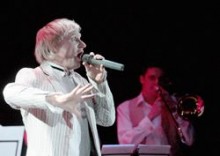Before the weekend, and thanks to the initiative of Oleh Skrypka, the capital’s club Sullivan Room Kiev was transformed into a jazz-cabaret. It resembled those of the 1930s-1940s, particularly in Lviv. Although at the time jazz orchestras were very popular in Soviet Ukraine, in the borderland city of Lviv the European culture of jazz peculiar to Poland or France was commonplace. In an authentic atmosphere of elegance and chic small restaurants and cafes the “Choir of Yablonsky” performed everywhere. Its core was composed of a director and violinist, always diminutively called Yabtsio, and two musicians – Anatolii Kos-Anatolsky and Bohdan Vesolovsky. Actually, the creative activity of the latter was thoroughly “restored” by the “Vopli Vidopliasova” band. As a result, a solo album will be released soon.
Bohdan Vesolovsky started composing songs at 16. At around 20, being a student of Lviv University and Lysenko Higher Musical Institute, he gained popularity. His Chorni ochi (Black Eyes), Usmikh (Smile), and especially Pryide shche chas (The Time will Come) were played in crowded concerts, student parties and other dwellings in Lviv. In 1938, foreboding the advent of the Soviet “liberators” to Galicia, he moved to Transcarpathia, which at that time was called an islet of Ukrainian independence. From there he moved to Austria, and then, to Canada. He died in Montreal in 1971 and left a considerable heritage – over a hundred songs. Among them is an original anthem of the Ukrainian post-war emigration in Canada Lety, tuzhlyva pisne (Fly, Sad Song).
In Ukraine his compositions continued to be performed in the 1950s, 1960s, and 1970s, but due to political motives the surname of the author was never mentioned. Only in the second half of the 1980s, during one of the concerts of the “Lviv Retro” group, Bogdan Vesolovsky was first mentioned as an embodiment of Ukrainian popular song. “In the jazz-cabaret I created there will be no cancan,” says Oleh Skrypka. “Instead, there will be a restoration of Ukrainian musical history, especially the creative activity of Bohdan Vesolovsky and Ukrainian jazz from the beginning of the 20th century. All the youth of Galicia and Bukovyna danced to these songs.”
Listening to the new solo program of Oleh Skrypka, which included the international hits Fever, Tombe La Neige, and Rien de Rien, I recollected how I once found the songbook of my grandmother, a student of the Polish Orzeszkowa Gymnasium in Ternopil. There, in an accurate girlish handwriting, were all the most popular songs of that time, particularly those of the Ukrainian Sich Riflemen. Holding them in my hands,
I thought: what do I know about my grandmother’s childhood? Turning over the pages of the songbook,
I encountered forbidden works, which were performed at her home when relatives came for holidays. It was part of the Ukrainian opposition movement.
“Oleh Skrypka accomplishes projects which raise questions about our identity in an unusual way,” meditates jazz expert Oleksii Kohan. “Obviously, contemporary young people are interested to learn what their grandparents sang and danced in the 1930s and 1940s. And to learn about those who created and spread urban romance as a genre. By the way, some works of that time could compete with the international popular songs! By exploring our musical heritage we, to some extent, establish a connection between generations.” One can also visit the jazz parties of Oleh Skrypka, which will take place in the mentioned club Sullivan Room Kiev, on April 1 and 8.







